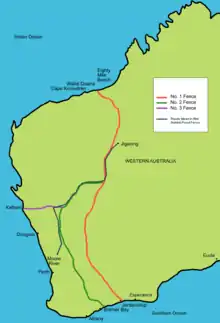Follow the Rabbit-Proof Fence
Follow the Rabbit-Proof Fence is an Australian book by Doris Pilkington, published in 1996. Based on a true story, the book is a personal account of an Indigenous Australian family's experiences as members of the Stolen Generation – the forced removal of mixed-race children from their families during the early 20th century. It tells the story of three young Aboriginal girls: Molly (the author's mother), Daisy (Molly's half-sister), and Gracie (their cousin), who are forcibly removed from their families at Jigalong and taken to Moore River, but escape from the government settlement in 1931, and then trek over 1,600 kilometres (990 mi) home by following the rabbit-proof fence, a massive pest-exclusion fence which crossed Western Australia from north to south.
.jpg.webp) | |
| Author | Doris Pilkington |
|---|---|
| Country | Australia |
| Language | English |
| Genre | Biography |
| Publisher | University of Queensland Press |
Publication date | 1996 |
| Pages | 136 pp |
| ISBN | 0-7022-2709-9 |
| Followed by | Under the Wintamarra Tree |
The book was adapted as a film, Rabbit-Proof Fence, in 2002.
More about Doris Pilkington
Doris Pilkington had spent much of her early life from the age of four at the Moore River Native Settlement in Western Australia, the same facility the book chronicles her mother, aunt's and cousin's escape from as children. After reuniting with her family 21 years later, Pilkington says she did not talk to her mother much, and she was not aware of her mother's captivity at Moore River nor the story of her escape, until her Aunt Daisy told her the story. Repeating the story at an Aboriginal family history event in Perth, one of the attendees told Pilkington he was aware of the story and that the case was fairly well-documented. He gave her some documents and clippings which formed the factual backbone of the story on which Pilkington based a first draft.[1]
Pilkington submitted the draft to a publisher in 1985 but was told it was too much like an academic paper and that she should try her hand at writing fiction. Her first novel, Caprice, A Stockman's Daughter, won the David Unaipon Literary Award and was published in 1990 by the University of Queensland Press. Pilkington then rewrote and filled out Follow the Rabbit-Proof Fence following several years of interviewing her mother and aunt, and it was published in 1996.[1] A third book in the trilogy was Under the Wintamarra Tree (2002). Pilkington also wrote an adaptation of Rabbit-Proof Fence for children called Home to Mother (2006),
Summary

Molly, her half-sister Daisy and their cousin Gracie are taken to Moore River for schooling to become more like a white person and to eventually be taken to a (more) rural part of Western Australia. The girls escaped from the Settlement and took the 1,600 km (990 mi) walk home along the rabbit-proof fence.[2]
Film adaptation
Shortly after the book's publication, the film rights were obtained by scriptwriter Christine Olsen, who wrote the script and was persistent in her pitching of the film to Hollywood-based Australian director Phillip Noyce. Noyce agreed to direct the film, which was released in 2002 and starred Everlyn Sampi as Molly, and British actor Kenneth Branagh as A. O. Neville, the Chief Protector of Aborigines.
References
- Quin, Karl (17 February 2002). "Molly's Story". The Sunday Age. Retrieved 6 December 2007.
- Matheo, Demetrios: The long walk home, The Daily Telegraph along the rabbit-proof fence. , 1 September 2002.